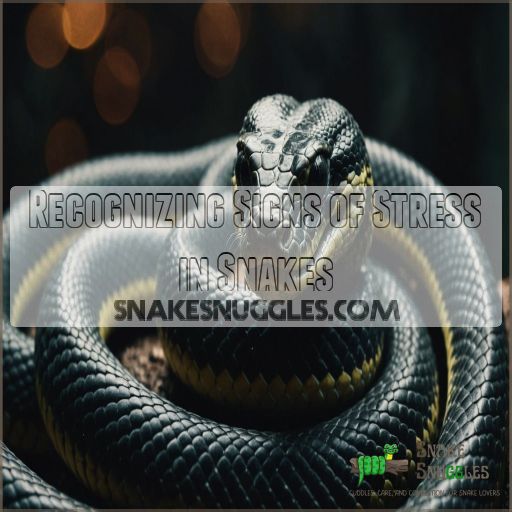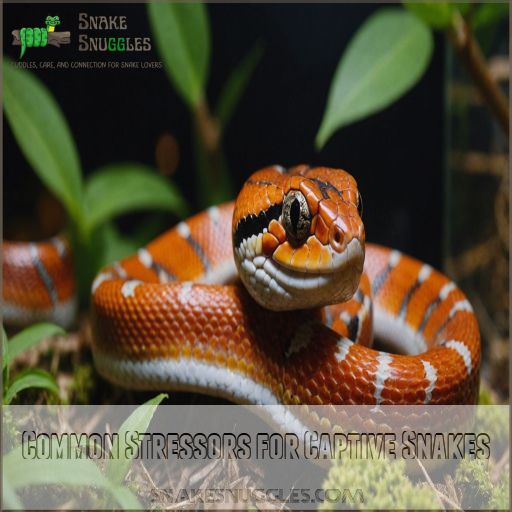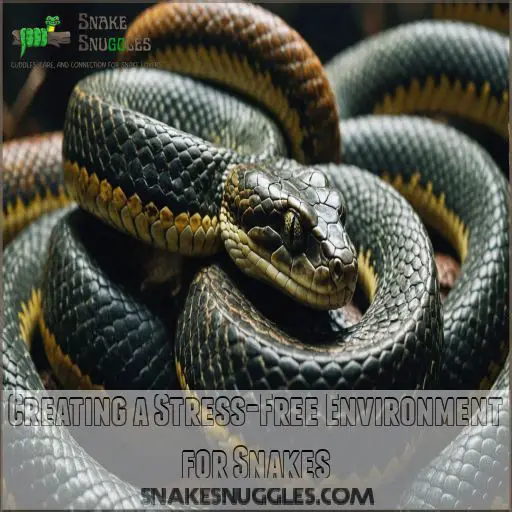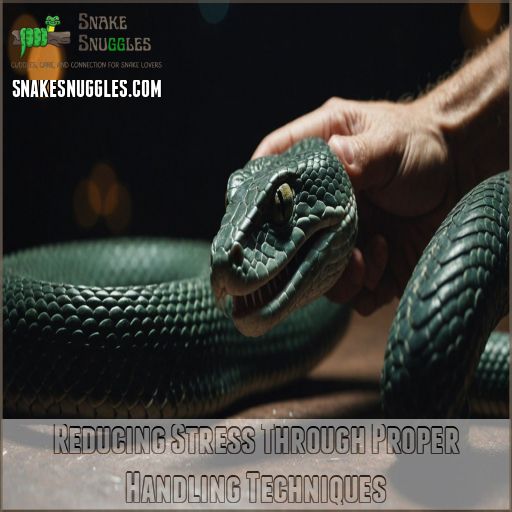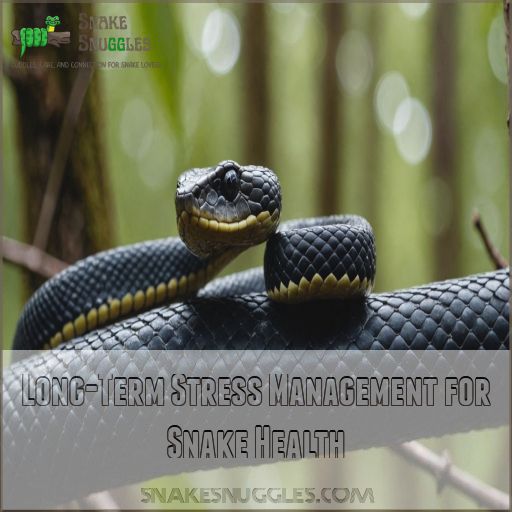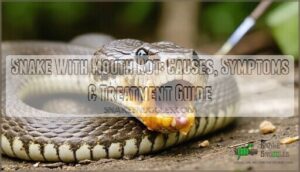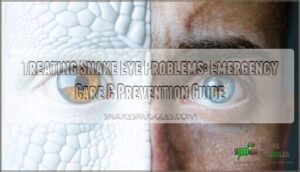This site is supported by our readers. We may earn a commission, at no cost to you, if you purchase through links.
 Noticing your snake is stressed? Fear not! Just like us reaching for our comfort snacks during trashy TV marathons, snakes show stress in various ways. Look for signs like heavy breathing, color changes around their mouths, or hiding more than usual—imagine them as introverts at a loud party.
Noticing your snake is stressed? Fear not! Just like us reaching for our comfort snacks during trashy TV marathons, snakes show stress in various ways. Look for signs like heavy breathing, color changes around their mouths, or hiding more than usual—imagine them as introverts at a loud party.
Their enclosure could be the culprit: too noisy, spacious, or not cozy enough. Make sure the space meets temperature needs and provides enough hiding spots. Handle them with care, like cradling a shimmering, scaly treasure.
Want to learn more about creating a peaceful paradise for your serpent pal? We can help you!
Table Of Contents
- Key Takeaways
- Recognizing Signs of Stress in Snakes
- Common Stressors for Captive Snakes
- Creating a Stress-Free Environment for Snakes
- Reducing Stress Through Proper Handling Techniques
- Long-Term Stress Management for Snake Health
- Frequently Asked Questions (FAQs)
- How do I know if a snake is stressed?
- How do you calm an anxious snake?
- How to make a snake less stressed?
- What stresses out snakes?
- Can social buffering reduce stress in pet snakes?
- How often should snakes be handled interactingly?
- What are the uses of hide boxes in enclosures?
- Does the owner’s proximity affect snake stress levels?
- Can the presence of other snakes ease stress?
- Conclusion
Key Takeaways
- Recognize stress signs in your snake by watching for changes like heavy breathing or hiding more often than usual. These are your scaly buddy’s way of waving a red flag, saying, "I’m not feeling too cozy right now!"
- Create a perfect home by ensuring the enclosure meets your snake’s needs. Think of it like setting up a five-star hotel—get the temperature, humidity, and hiding spots just right to keep your snake smiling, even if it doesn’t show it!
- Handle your snake like cradling a precious gem. Don’t overdo it with forced cuddles; let your snake set the pace. It’s like making friends with a shy introvert who needs a little space to warm up.
- Offer enrichment activities to combat boredom, like puzzle feeders and climbing structures. Think of it as giving your snake a mini adventure every day, keeping life exciting and stress-free.
Recognizing Signs of Stress in Snakes
You might think your scaly friend is just being moody, but there’s more to it than that.
Recognizing signs of stress in snakes is really important for their well-being, and it’s not as tricky as you’d imagine once you know what to look for.
Physical Indicators of Stress
Your snake’s body speaks volumes about its stress levels. Keep an eye out for these telltale physical signs:
- Heavy breathing or rapid heart rate
- Muscle tremors or twitching
- Skin discoloration, especially around the mouth
These red flags shouldn’t be ignored!
Behavioral Changes Indicating Stress
Now that we’ve covered physical signs, let’s talk behavior. Your slithery friend might be feeling the heat if you notice these changes:
| Behavior | Normal | Stressed |
|---|---|---|
| Appetite | Eats regularly | Refuses food |
| Activity | Explores enclosure | Hides excessively |
| Tongue flicking | Occasional | Rapid, frequent |
Stress-induced Defensive Responses
When your snake feels threatened, it may resort to stress-induced defensive responses. These behaviors are its way of saying, "Back off!"
Here are three common defensive mechanisms:
- S-shaped coiling
- Hissing or tail rattling
- Striking or biting (usually without venom)
Physiological Symptoms of Snake Stress
Beyond defensive postures, stressed snakes exhibit telling physiological symptoms.
You’ll notice heavy breathing, muscle tremors, and a sudden loss of appetite.
Keep an eye out for shedding issues and reduced activity.
These signs are your snake’s way of waving a red flag when you see these signs.
Environmental Factors Causing Stress in Snakes
Ever wondered what’s stressing your scaly friend?
Your snake’s home might be the culprit!
From cramped quarters to noisy neighbors, environmental factors can turn your serpent’s paradise into a pressure cooker.
Let’s explore these sneaky stressors together.
Common Stressors for Captive Snakes
Your scaly friend might be feeling a bit on edge, and it’s not just because they woke up on the wrong side of the branch. From handling hiccups to habitat hassles, captive snakes face a slew of stressors that can turn their cozy enclosure into a pressure cooker of reptilian anxiety.
Improper Handling Techniques and Frequency
Handling your snake can be a slippery slope. You might think you’re bonding, but excessive handling can stress your scaly friend. Here’s why it’s important to handle with care:
- Your snake’s not a stress ball
- Forced cuddles? No thanks!
- Too much love can backfire
- Respect the hiss, not the kiss
Inadequate Enclosure Conditions
Your snake’s home matters. While proper handling is key, an inadequate enclosure can wreak havoc on your scaly friend’s well-being.
Let’s explore how your snake’s living space might be causing stress:
| Enclosure Issue | Stress Impact |
|---|---|
| Too small space | Claustrophobia |
| Wrong substrate | Discomfort & infections |
| Poor temperature | Sluggishness or hyperactivity |
| Inadequate lighting | Disrupted day/night cycles |
Disruptions to Natural Behavior Patterns
Snakes need routines and environments that mirror their instincts. Sudden changes can stress them out, like when someone tries learning algebra overnight. Common disruptions include:
- Enclosure size issues
- Hibernation timing
- Feeding schedules
- Substrate choices
- Incorrect lighting
Social Factors and Snake Stress
Social isolation’s a real stressor for some snakes.
Ever tried "snake social buffering" with tank mates?
Group housing might ease anxiety.
Solitary snakes?
They may enjoy alone time, but consider their personality; maybe they’re closet social butterflies.
Diet-related Stressors in Captivity
Switching gears from social dynamics, let’s talk about diet-related stress for snakes.
Overfeeding, nutritional deficiencies, and improper diet composition can cause digestive issues.
Just like us after Thanksgiving dinner, snakes need balanced nutrition and food frequency.
Creating a Stress-Free Environment for Snakes
Providing your snake with a stress-free environment is really important for its overall well-being.
From optimizing the enclosure setup to minimizing external disturbances, we’ll explore expert solutions to keep your slithery friend calm and content.
Optimal Enclosure Design and Setup
When creating your snake’s sanctuary, make sure to use the right substrate and provide ample ventilation, as fresh air’s like a spa for their soul.
Correct lighting and enough space aren’t merely decor—they’re the ambiance for healthy and happy scaled occupants.
Providing Appropriate Hiding Spaces
Give your snake a cozy nook!
Choose dark, snug hiding spot materials like plastic or cork.
Make sure the hide’s size and shape match your snake’s needs.
Place multiple hides for security.
Your snake will thank you!
Maintaining Ideal Temperature and Humidity Levels
A cozy terrarium feels like home when you nail temperature gradients and humidity control.
Remember these steps: 1. Use heating methods for comfort.
- Pick a substrate choice optimizing moisture.
- Make sure there’s good ventilation for fresh airflow.
Establishing a Consistent Routine
Establishing a consistent routine is key for your snake’s wellbeing.
Stick to a predictable feeding schedule, lighting cycle, and cleaning routine.
Consistent enclosure access and water changes will help your slithery friend feel secure and at ease.
Minimizing External Disturbances
Your snake’s routine is like a calming sunbeam. Interruptions can create shadows.
Noise reduction, vibration control, and consistent light changes help.
Place your enclosure thoughtfully; handle them at the right times to maintain their peaceful oasis.
Reducing Stress Through Proper Handling Techniques
Handling a snake incorrectly can lead to stress, but don’t worry, there are ways to keep your scaly friend happy!
By understanding how often to handle them and using gentle techniques, you can build trust and create a relaxed environment that both you and your snake will enjoy.
Appropriate Frequency of Snake Handling
Handling your snake with the right frequency can make all the difference in temperament and trust-building.
Consider these tips:
- Start with brief, gentle interactions.
- Observe the snake’s age; older snakes may tolerate handling better.
- Make handling a low-stress, owner-driven activity.
Safe and Gentle Handling Methods
Gently cradle your snake, supporting its entire body.
Move slowly and avoid sudden motions that could startle it.
Speak softly and offer treats to associate handling with positive experiences.
Patience and care will help build trust over time.
Building Trust Through Positive Experiences
After practicing safe handling, let’s chat about building trust with your snake.
Think of it like gaining a friend’s confidence: take it slow, follow their cues, and avoid frequent handling.
Observe the snake’s temperament and offer enrichment activities for positive reinforcement and social interaction.
Adjusting Handling Based on Individual Snake Needs
Building trust with your snake is like trying to win over a shy friend—with patience and respect.
Each snake has unique needs, so pay attention to stress indicators and adjust handling frequency to suit their temperament.
- Observe: Tail vibrations, hissing, or defensive posture.
- Adjust: Limit handling if stress signs appear.
- Personalize: Timing and frequency should match the snake’s comfort level.
Long-Term Stress Management for Snake Health
Managing your snake’s stress is like playing "snake charmer," but with a modern twist!
By integrating regular health checks, good nutrition, and engaging enrichment activities, you can help your scaly friend remain as cool and collected as a cucumber over time.
Regular Health Monitoring and Veterinary Care
Regular vet checkups catch issues early, so your snake stays healthy and stress-free.
Find an experienced reptile vet who can provide the preventative care and parasite control your slithery friend needs to thrive.
Nutritional Considerations for Stress Reduction
To keep your snake stress-free, think like a five-star chef: balance nutrition as a recipe for relaxation.
Make sure you offer a varied diet with appropriate vitamins and minerals.
And keep hydration top-of-mind for slithery satisfaction!
Enrichment Activities to Alleviate Boredom
When your snake seems bored, spice up its life! Try enriching activities with:
- Climbing Structures: Encourage exploration like Indiana Jones!
- Puzzle Feeders: Make mealtime a crafty caper!
- Scent Enrichment: Introduce irresistible aromas to ignite curiosity!
Addressing Species-specific Stress Factors
Let’s address how species-specific needs help tackle stress.
Each snake has its quirks—like your uncle’s weird uncle.
Learn behavior patterns, adapt habitats, and mind breeding considerations to dodge stress triggers.
Tailor your snake’s world accordingly!
Implementing Stress Reduction Strategies Over Time
Implementing stress reduction strategies takes time and patience. Gradually introduce enrichment activities, adjust handling frequency, and monitor your snake’s progress.
With care and understanding, you can create a tranquil environment that meets your snake’s unique needs.
- Introduce enrichment activities slowly
- Adjust handling frequency based on response
- Monitor progress and make adaptations
- Provide a consistent, calming environment
Frequently Asked Questions (FAQs)
How do I know if a snake is stressed?
Ironically, the calm snake that never bites or hisses might still be stressed.
Watch for heavy breathing, musking, or tail whipping—like your snake’s version of a spa day gone wrong.
Curious tongues tell a better tale.
How do you calm an anxious snake?
To calm an anxious snake, create a secure, stress-free environment with ample hiding spots.
Avoid frequent handling, and let the snake initiate interactions.
Patience and understanding go a long way in building trust with your scaly friend.
How to make a snake less stressed?
Calming a stressed snake is like soothing a jittery violin string—give them secure hiding spots, reduce handling, and create a peaceful environment.
Observe their behavior closely to understand and address their stress triggers effectively.
What stresses out snakes?
Snakes stress out when they’re handled too often, startled by sudden movements, or face changes in their environment.
They prefer consistent routines, snug hiding spots, and minimal human interaction, which helps keep their scaly spirits calm.
Can social buffering reduce stress in pet snakes?
Even snakes enjoy a bit of "buddy time!"
Having a cagemate might ease pet snake stress, like sharing a stormy night with a friend.
But remember, some snakes still prefer flying solo, even at a party.
How often should snakes be handled interactingly?
You don’t need to handle your snake twice daily – that’s way too often!
Aim for just a few minutes, once or twice a week.
Let your slithery friend set the pace and you’ll both feel more at ease.
What are the uses of hide boxes in enclosures?
Hide boxes are little havens for your slithery buddy, offering them a snug retreat.
They help snakes feel safe and sound, like cozy forts against life’s hustle, reducing stress and providing security in their enclosure.
Does the owner’s proximity affect snake stress levels?
Imagine a snake lounging near your bustling desk, and wonder if it’s anxious.
Proximity might increase its stress, like hosting a jungle gym in its home!
Observing behavior offers insights, adjusting accordingly helps keep the peace.
Can the presence of other snakes ease stress?
Introducing another snake into the mix might just do the trick!
The presence of a cagemate could create a calming effect, offering that social buffering magic, akin to a soothing cup of herbal tea.
Conclusion
Ultimately, your snake’s well-being is in your hands.
By staying vigilant for signs of stress and creating a soothing sanctuary, you’ll help your slithery pal thrive.
With a little TLC, you can turn your terrarium into a tranquil oasis where your snake is stress-free and ready to bask in your affection.
The key is understanding their needs and making adjustments to keep them content and comfortable.

